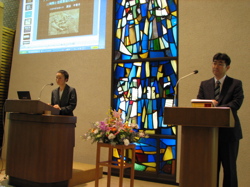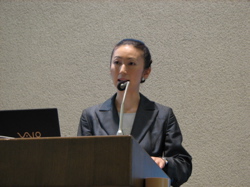Center for Interdisciplinary Study of Monotheistic Religions(CISMOR)Doshisha University
> Public Lectures > Pictorial Narratives Represented in Late Assyrian Reliefs during the Reign of AssurbanipalPublic Lectures
Lecture (Open for the public)
Pictorial Narratives Represented in Late Assyrian Reliefs during the Reign of Assurbanipal
| Date: |
2007/07/07 14:00-16:00 |
|---|---|
| Place: | Chapel in the Divinity Hall, Imadegawa Campus, Doshisha Univ. |
| Lecture: | Chikako Watanabe (Assistant Professor, Department of International Studies, Osaka Gakuin Junior College) |
| Summary: | |
|
In this lecture, Professor Watanabe introduced the representation of space and time in the pictorial narratives of Assyrian reliefs, using numerous slides for illustration. She treated the style of representation in Assyrian art called 'continuous style,' which is defined as 'plural movements or actions at different moments by the same character, represented in a unified space.' It is a means of representing continuous 'narratives' involving a particular character in a specific time and space. After Lessing, a German writer, criticized the continuous style in 1766 as an infringement on the poet’s territory by the painter, the world of art came to value depicting 'a decisive moment' having the most implication in the narrative, a scene at a single instant, and tabooed forms of representation bringing different moments of time into a picture. This paradigm was changed by Wickhoff, an art historian at the end of the nineteenth century, based on his study of an illustrated codex of the sixth century. He suggested three kinds of representation-'completing style,' 'distinguishing style,' and 'continuous style'-to be possible in visual art. In the history of Assyrian art, the earliest example of representation by continuous style appears on a relief showing the king Tukulti-Ninurta in the thirteenth century B.C. Here, in the same picture, the king is depicted both approaching an altar and kneeling before it. These movements from two specific, mutually closely-related moments arose in continuous time. Thus, the continuous style contains different representations that are of 'continuous actions' arising in a relatively short period of time, and 'continuous scenes' representing the process of narrative time through each independent scene. The continuous style developed further in the middle of the seventh century B.C., noticeably on King Assurbanipal’s relief depicting 'the Battle of Til-Tuba.' This is an epoch-making work because it introduces techniques to suggest not only the process of 'time' but also the extent of 'space.' It applied 'continuous action' to time, and 'vertical perspective' to space-this is characteristic of Assyrian art, depicting things closer to the viewer in the lower part of the screen, and things further away in the upper part. This relief is also accompanied with detailed inscriptions, so that one can follow the main plot of the narrative by two means, image and text. Such 'continuous action' attracts the viewer’s interest and concern for the development of the narrative, and has the effect of making the action present, as if one were witnessing each event there. Then there are royal lion hunt reliefs excavated at a northern palace, where, although the continuous style is used, the temporal transitions are not clear; they seem to depict the same person’s different sides on one screen. And different from the above-mentioned continuous style, reliefs showing the king Assurbanipal reviewing the booty from Babylon after the Assyrian army conquered it in 648 B.C. represent events which occurred not only at different times in the same space, but also some that occurred in different times and different places. This is confirmed by checking the related inscriptions. Thus, despite dealing with historical events, the relief from the time of Assurbanipal in the seventh century B.C. composes the screen freely without being caught in the actual time or space of the event. It was intended to impress upon the viewer the power of the Assyrian army and the king’s greatness by uniting different segments of time and space while forming a 'narrative' little different from reality. The relief, created as a palatial decoration, is understood to function as visual media appealing to the viewer, and producing dramatic political propaganda. Tomoki Asaka (CISMOR Research Assistant / Graduate Student of School of Theology, Doshisha University) |
|

